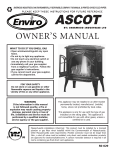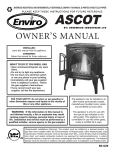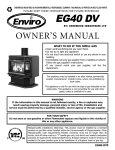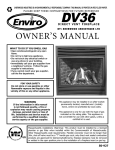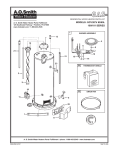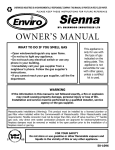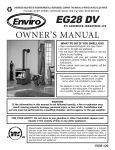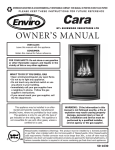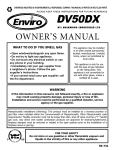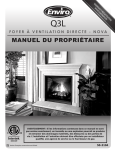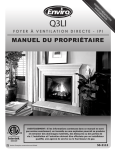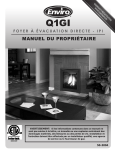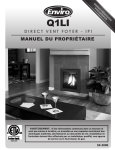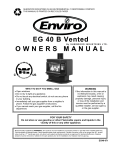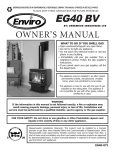Download Enviro Ascot 50-029 User's Manual
Transcript
SHERWOOD INDUSTRIES IS AN ENVIRONMENTALLY RESPONSIBLE COMPANY. THIS MANUAL IS PRINTED ON RECYCLED PAPER. ASCOT PLEASE KEEP THESE INSTRUCTIONS FOR FUTURE REFERENCE BY: SHERWOOD INDUSTRIES LTD OWNER’S MANUAL WHAT TO DO IF YOU SMELL GAS • Open windows/Extinguish any open flame. • Do not try to light any appliance. • Do not touch any electrical switch or use any phone in your building. • Immediately call your gas supplier from a neighbour’s phone. Follow the gas supplier’s instructions. • If you cannot reach your gas supplier, call the fire department. WARNING If the information in this manual is not followed exactly, a fire or explosion may result causing property damage, personal injury or loss of life. Installation and service must be performed by a qualified installer, service agency or the gas supplier. This appliance may be installed in an after market permanently located, manufactured (mobile) home, where not prohibited by local codes. This appliance is only for use with the type of gas indicated on the rating plate. This appliance is not convertible for use with other gases, unless a certified kit is used. FOR YOUR SAFETY: Do not store or use gasoline or other Flammable vapours and liquids in the vicinity of this or any other appliance. Massachusetts installations (Warning): This product must be installed by a licensed plumber or gas fitter when installed within the Commonwealth of Massachusetts. Other Massachusetts code requirements:-Flexible connector must not be longer than 36 inches, shut off valve must be a “T” handle gas cock, only direct vent sealed combustion products are approved for bedroom/bathrooms, fireplace dampers must be removed or welded in the open position prior to the installation of a fireplace insert or gas log. 50-029 Safety Precautions FOR SAFE INSTALLATION AND OPERATION OF YOUR “ENVIRO” HEATER, PLEASE CAREFULLY READ THE FOLLOWING INFORMATION: • All ENVIRO gas-fired appliances must be installed in accordance with their instructions. Carefully read all the instructions in this manual first. Consult the building authority having jurisdiction to determine the need for a permit prior to commencing the installation. • NOTE: Failure to follow these instructions could cause a malfunction of the fireplace, which could result in death, serious bodily injury, and/or property damage. • Failure to follow these instructions may also void your fire insurance and/or warranty. GENERAL • Installation and repair should be done by a qualified service person. The appliance should be inspected before the first use and, at least, annually by a qualified service person. More frequent cleaning may be required due to excessive lint from carpeting, bedding material, etc. It is imperative the control compartments, burners and circulating air passageways of the appliance be kept clean. • Due to high temperatures, the appliance should be located out of high traffic areas and away from furniture and draperies. Children and adults should be alerted to the hazards of high surface temperatures and should stay away to avoid burn or clothing ignition. • Young children should be carefully supervised when in the same room as the appliance. • Clothing or other flammable materials should not be placed on or near the appliance. FOR YOUR SAFETY • Installation and service must be performed by a qualified installer, service agency or gas supplier. • This installation must conform to local codes or, in the absence of local codes, to the current CAN/CGAB149 installation code (Canada) or National Fuel Gas Code ANSI Z223.1.2 (USA) 2 • To prevent injury, do not allow anyone who is unfamiliar with the stove to operate it. • To prevent injury, if the pilot or pilot and burners have gone out on their own, open the glass door and wait 5 minutes to air out before attempting to re-light the stove. • Always keep the area around these appliances clear of combustible material, gasoline and other flammable liquids and vapours. • These appliances should not be used as a drying rack for clothing or for hanging Christmas stockings/ decorations. • Due to the paint curing on the stove, a faint odor and slight smoking will likely be noticed when the stove is first used. Open a window until the smoking stops. Always connect this gas stove to a vent system and vent to the outside of the building envelope. Never vent to another room or inside the building. Make sure the specified vent pipe is used, properly sized and of adequate height to provide sufficient draft. Inspect the venting system annually for blockage and signs of deterioration. WARNING: Failure to position the parts in accordance with the diagrams in this booklet, or failure to use only parts specifically approved with this appliance, may result in property damage or personal injury. WARNING: Do not operate with the glass front removed, cracked or broken. Replacement of the glass should be done by a licensed or qualified service person. • Never use solid fuels such as wood, paper, cardboard, coal, or any flammable liquids, etc., in this appliance. • Do not use this heater if any part has been under water. Immediately call a qualified service technician to inspect the heater and to replace any part of the control or gas control systems that have been under water. • Do not abuse the glass by striking it or slamming the door shut. Table of Contents Safety Precautions....................................................................................................2 Table of Contents......................................................................................................3 Codes And Approvals.................................................................................................4 Specifications...........................................................................................................5 Dimensions....................................................................................................5 Clearances to Combustibles............................................................................5 Operating Instructions...............................................................................................6 Lighting Instructions.......................................................................................6 Pilot Light......................................................................................................6 Maintenance And Service...........................................................................................7 Routine Maintenance......................................................................................7 Cleaning The Glass.........................................................................................7 Cleaning The Firebox......................................................................................7 Change Battery in Ignition Module...................................................................7 Replacing Glass..............................................................................................8 Opening The Door..........................................................................................8 Fuel Conversion.............................................................................................9 Initial Installation....................................................................................................10 Vent Termination Restrictions........................................................................10 Vent Parts....................................................................................................11 Vent Restrictor Setting..................................................................................12 Planning Your Installation.............................................................................13 Horizontal Installation...................................................................................14 Vertical Installation.......................................................................................17 Freestanding Drafthood Adaptor....................................................................19 Hearth Mount Installation.............................................................................22 Gas Line Connection and Testing...................................................................23 Electrical Requirements.................................................................................24 Installation of Optional Blower.......................................................................24 Secondary Installation.............................................................................................25 Installation of Log Set and Embers................................................................25 Trouble Shooting.....................................................................................................27 Parts List................................................................................................................28 Parts Diagram.........................................................................................................31 Warranty................................................................................................................32 Installation Data Sheet............................................................................................33 3 Codes And Approvals DIRECT VENT ONLY: This type is identified by the sufix DV. This appliance draws all of its air for combustion from outside the dwelling, through a specially designed vent pipe system. ** TOP VENT DV ONLY** This appliance has been tested and approved for installations from 0 feet to 4500 feet (1372 m) above sea level. In the USA: The appliance may be installed at higher altitudes. Please refer to your American Gas Association guidelines which state: the sea level rated input of Gas Designed Appliances installed at elevations above 2000 (610 m) feet is to be reduced 4% for each 1000 feet (305 m) above sea level. Refer also to local authorities or codes which have jurisdiction in your area regarding the de-rate guidelines. In Canada: When the appliance is installed at elevations above 4500 feet (1372 m), the certified high altitude rating shall be reduced at the rate of 4% for each additional 1000 feet (305 m). • This appliance has been tested by INTERTEK (Warnock Hersey) and found to comply with the established VENTED GAS FIREPLACE HEATER standards in CANADA and the USA as follows: VENTED GAS FIREPLACE HEATER (ASCOT DV; NG/LPG) TESTED TO: ANSI Z21.88a-2003/CSA 2.33a-2003 VENTED GAS FIREPLACE HEATERS CAN/CGA 2.17-M91 GAS FIRED APPLIANCES FOR HIGH ALTITUDES CSA P.4.1-02 TESTING METHOD FOR MEASURING ANNUAL FIREPLACE EFFICIENCY This ENVIRO ASCOT Fireplace: • Has been certified for use with either natural or propane gases. (See rating label.) • Is not for use with solid fuels. • Is approved for bedroom or bed sitting room. (IN CANADA: must be installed with a listed wall thermostat. IN USA: see current ANSI Z223.1 for installation instructions.) • Must be installed in accordance with local codes. If none exist, use current installation code CAN/CGA B149 in Canada or ANSI Z223.1/NFPA 54 in the USA. • Must be properly connected to an approved venting system and not connected to a chimney flue serving a separate solid-fuel burning appliance. IMPORTANT NOTICE (Regarding first fire up): When the unit is turned on for the first time, it should be turned onto high without the fan on for the first 4 hours. This will cure the paint, logs, gasket material and other products used in the manufacturing process. It is advisable to open a window or door, as the unit will start to smoke and can irritate some people. After the unit has gone through the first burn, turn the unit off including the pilot, let the unit get cold then remove the glass door and clean it with a good gas fireplace glass cleaner, available at your local ENVIRO dealer. 4 Specifications DIMENSIONS: �� ����� �������� �� ���� �������� �� ����� �������� �� ���� �������� �� ����� �������� �� ������ �������� �� ����� �������� �� ����� �������� Height: 24 1/16 inches (611 mm) Width: 19 1/16 inches (484 mm) Depth: 15 5⁄8 inches (397 mm) Center of flue to ground without leveling legs: 18 3⁄8 inches (467 mm) Center of flue to ground with leveling legs (approx.): 19 inches (483 mm) �� ����� �������� Figure 1. Dimensions of the Ascot. CLEARANCES TO COMBUSTIBLES: � ����� � � �� �� � � �������� ���� If this unit is installed in an alcove the alcove must meet these minimum dimensions: Width 48 inches (1219 mm) Height 60 inches (1524 mm) Maximum Depth 24 inches (610 mm) �������� ���� ���� ���� ���� ���� A) Sidewall to unit 10 inches (254 mm) B) Backwall to unit 21⁄2 inches (64 mm) C) Corner to unit 21⁄2 inches (64 mm) D) Ceiling bottom of unit 60 inches (1524 mm) E) Floor 0 inches (0 mm) Must have hearth pad if installed on a carpeted surface. Figure 2: Clearances to combustibles. WARNING: Operation of this heater when not connected to a properly installed and maintained venting system or tampering with the vent safety shutoff system can result in carbon monoxide (CO) poisoning and possible death. 5 Operating Instructions FOR YOUR SAFETY READ COMPLETELY BEFORE OPERATING. LIGHTING INSTRUCTIONS: while operating. Do not touch. Keep children, clothing, CAUTION:Hot furnit ure, gasoline or other flammable vapors away. FOR YOUR SAFETY: Do not operate this fireplace with the glass removed, cracked or broken. Replacement of this glass should be done by a licensed or qualified person! This appliance needs fresh air for safe operation and must be installed with provisio ns for combustion and ventilation air. See installation and operating instructions manual. Keep burner and control compartment clean . WARNING: Improper installation, adjustment, alteration , service or maintenance can cause property damage, personal injury, or loss of life. Refer to owners manual. Installation and service must be performed by qualified installer, service agency or the g as supplier. FOR YOUR SAFETY READ BEFORE OPERATING WARNING: IF YOU DO NOT FOLLOW THESE INSTRUCTIO NS EXACTLY, A FIRE O R EXPLOSION MAY RESULT CAUSING PROP ERTY DAMAGE, PERSONAL INJURY OR LOSS OF LIFE. A) This applianc e is e quippe d with a pilot, whic h mus t be lit by If y ou cannot re ach y our gas supp lier, c all the fire departm ent. hand b y following these instruc tions e xactly. C) Use only y our ha nd to p ush in or tu rn the gas co ntrol k nob, B) BEFORE LIGHTING smell all around the appliance area Neve r use tools. If the k nob will not push in or turn by f or gas and n ext to the floor because some gas is heavi er hand , do n ot try to rep air it. t han air and will se ttle on the floor. Call a qual ified s ervice techn ician. Force or attempte d WHAT TO DO IF YOU SMELL GAS: repair may result in a fire or explosion. Do not try t o light any a pplian ce. Do not touch a ny electrical D) Do n ot use thisa pplian ce if any part has b een u nder water. switc h: do not use any phone in you r building. Immediately call a qualified service technician to inspe ct Immediately call your gas sup plier f rom a neighbors p hone. the a ppliance an d to replace any pa rt of t he con trol system Follo w the gas s upplie rs instr uctions. and any ga s con trol which ha s been unde r water. LIGHTING INSTRUCTIONS 1. STOP! Read th e safe ty information above on th is labe l. 2. Turn off all elec trical power t o this applian ce. 3. Turn off t he gas contr ol knob clock wise to the off position. 4. Open door. Wa it five (5) minutes to clear out any gas. Cl ose do or. If y ou sme ll gas , includ ing ne ar the floor , STOP! Follow “ B” in the above safety inf ormation. If y ou do not smell gas go to the ne xt ste p 5. Fin d pilo t-locate d to th e righ t behin d the side log. Turn the gas c ontrol kn ob cou nter-clockwise to “PILO T”. Push the gas co ntrol in ful ly and hold, Keep k nob depressed for a bout 30 seco nds after pilot is lit. Release kno b. If p ilot goes out , rep eat st eps 4 t hrough 5. WARNING: this gas valve ha s a loc kout device, which will n ot allow the pilot burner to be relit until the ther mocouple h as cooled. If the knob does not po p up when released, s top and imme diately call yo ur serv ice tec hnician or gas s upplier. I f the pilot does not stay lit after several tries, turn the gas c ontrol knob to “OFF” and call your servic e technician or g as supplier. 6. Turn the gas control k nob counter clockwise t o the “ON” position. Flip the burner switch to “ON” THEN TURN THE “HI/LOW” k nob to the desired setting. 7. Turn on the ele ctrical power to the unit. TO TURN OFF GAS TO APPLIANCE 1. Fli p burn er switch to “OFF” 2. Turn the gasco ntrol k nob c lockwise po sition to th e “OF F” 3 . Turn off all electrical po wer to the ap plianc e if service i sto be performe d. ACLIE -1 Figure 3. Lighting instruction label. PILOT LIGHT: 1. Turn off the gas to the fireplace. If not recently done, remove the glass and let the unit air out for at least five (5) minutes to clear out any gas. Turn on gas to the heater. Leak test all joints with soapy water. NEVER USE AN OPEN FLAME FOR LEAK TESTING. 2. Start the pilot by pressing the gas control knob and turning it to PILOT. While holding the gas control knob in, press the piezo ignitor several times until the pilot light starts. Hold the gas control knob in for thirty (30) seconds. Check that the pilot has fully engulfed the thermocouple assembly (see Figure 4). ���������� ������������ 3. Start the main burner by turning the gas control knob to ON and then turn the rocker switch to ON. Check that all burner ports have flame. 4. Leak test all gas joints again. 6 Figure 4. Pilot flame. Maintenance And Service ROUTINE MAINTENANCE: At least once a year, run through the following procedures to ensure the system is clean and working properly. Check the burner to see if all the ports are clear and clean. Check the pilot to make sure it is not blocked by anything. The pilot flame should be blue with little or no yellow on the tips. Warning: Clearances must be sufficient to allow access for maintenance and service Warning: Failure to position the parts in accordance with this manual, or failure to use only parts specifically approved with this appliance may result in property damage or personal injury. The venting system must be periodically examined; it is recommended the examination is done by a qualified agency. CLEANING THE GLASS: When the fireplace has cooled, remove the face of the fireplace along with the glass. See MAINTENANCE AND SERVICE - GLASS DOOR REMOVAL. Check the gasket material on the back of the glass, making sure that it is attached and intact. It will be necessary to clean the ceramic glass periodically. During a cold start up, condensation will sometimes form on the glass. This is a normal condition with all fireplaces. However, this condensation can allow dust and lint to cling to the glass surface. Initial paint curing of the appliance can leave a slight film behind the glass, a temporary problem. The glass will need cleaning initially after the first 4 hours of use and again about two (2) weeks after installation. Use a mild glass cleaner and a soft cloth; abrasive cleaners will damage the glass and enamal surfaces. Depending on the amount of use, the glass should require cleaning no more than two or three times a season. Do not clean the glass when it is hot. CLEANING THE FIREBOX: Remove the logs carefully, as they are very fragile. Gently remove all the embers and rock wool and place on a paper towel. Vacuum the bottom of the firebox thoroughly. Carefully clean any dust off the logs and remove any lint from the burner and pilot. At this time, inspect the burner pan for cracking or severe warping. If a problem is suspected, contact the dealer. Check the logs for deterioration or large amounts of soot; a small amount on the bottom side of the logs is normal. Replace the logs and embers as in the LOG SET AND EMBER INSTALLATION section. If new/more embers and rock wool are required, contact your nearest ENVIRO dealer. CHANGE BATTERY IN IGNITION MODULE: If the unit does not spark when lighting, the battery in the electronic ignition could need replacing. The ignition module is located at the far left behind the valve cover (see Figure 6). Remove the battery cover, located on the left side of the module, and replace the AA battery. Reinstall the battery cover and check for spark by depressing the pilot knob located on the control panel. 7 Maintenance And Service REPLACING GLASS: The glass in the fireplace is a high temperature ceramic. If the glass is damaged in any way, a factory replacement is required (see PARTS LIST - COMPONENTS). Wear gloves when handling damaged glass door assembly to prevent personal injury. When the glass door assembly is being transported, it must be wrapped in newsprint and tape and/or a strong plastic bag. Do not operate with the glass front removed, cracked or broken. Removal and replacement of the glass from the door must be done by a licensed or qualified service person. The glass must be purchased from an ENVIRO dealer. No substitute materials are allowed. To Replace: • Open door, and remove the glass carefully. • Install the new piece of glass with the large bulb in the gasket tape against the unit. Place the joint in the tape in a bottom corner. Close door. OPENING THE DOOR: Turn unit off and wait until the appliance has cooled down. Remove the cast iron top from the unit by lifting straight up. Lift the two door handles located on either side of the door and lift the glass door assembly straight up and out. Carefully open the two doors and remove if necessary. Ensure the door is properly fastened after cleaning before attempting to re-light the appliance. Figure 5. Removing inner glass door. 8 Maintenance And Service TO BE INSTALLED BY A QUALIFIED SERVICE AGENCY ONLY FUEL CONVERSION: Warning: This conversion kit shall be installed by a qualified service agency in accordance with the manufacturer’s instructions and all applicable codes and requirements of the authority having jurisdiction. If the information in these instructions is not followed exactly, a fire, explosion or production of carbon monoxide may result causing property damage, personal injury or loss of life. The qualified service agency is responsible for the proper installation of this kit. The installation is not proper or complete until the operation of the converted appliance is checked as specified in the manufacturer’s instructions supplied with the kit. Please read and follow these instructions. Also, please read the instruction guidelines provided by S.I.T. on how to remove and install the HI/LO regulator. Step 1. Carefully inspect all parts supplied with this conversion kit. Step 2. Shut the gas supply off at the shut-off valve. (CAUTION: The gas supply shall be shut off prior to disconnecting the electrical power, before proceeding with the conversion.) Ignition Hi/Low Regulator Step 3. Open the door by lifting the cast iron top off of the unit. Module on Gas Valve Pull the two handles straight up to unlatch the door. Using Figure 6. SIT Valve on Ascot. the two latches lift the door assembly straight up and out of the unit. Swing the front doors open or remove for access the inside of the firebox. Step 4. Change the regulator on the front of the gas valve (follow the instructions provided by S.I.T.). Step 5. To change the pilot, simply pull the pilot hood straight up to access the pilot injector. Using a 5/32 inch Allen key, remove the pilot injector. Step 6. Install the new pilot injector supplied with this conversion kit. Simply screw the new injector inside the pilot hood and reinstall the hood by placing the hood on the assembly, line up the key way, and snap into place. Step 7. Remove the main burner orifice with a 1⁄2 inch deep socket. Step 8. Install the new orifice supplied. Be sure to put a bead of pipe-thread sealant or approved Teflon tape on the orifice before installing into the burner assembly. Step 9. Reinstall the burner tray, log set, embers, and glass. Step 10.Open the shut-off valve at the gas line to the unit. Step 11.Use a small brush to apply a warm soapy water solution to all gas connections (use a half dish soap and half warm water). If a gas leak is present, bubbling will occur. Gas leaks can be repaired by using an approved pipe thread sealant or approved Teflon tape. NEVER USE A NAKED FLAME WHEN TESTING FOR LEAKS. Step 12.Re-light the fireplace to ensure proper operation and proper flame appearance. Step 13.MAKE SURE that the sticker provided by S.I.T. is installed, to signify that the valve has been converted to a different fuel type. Also, make sure that the rating plate has a conversion label to show this unit has been converted to a different fuel type. A VISUAL CHECK OF THE REGULATOR KNOB IS NECESSARY TO DETERMINE WHETHER OR NOT THE REGULATOR IS THE CORRECT PART. A 50% TURN DOWN REGULATOR WILL HAVE ONLY ONE CORNER ON THE KNOB Conversion Kit should contain the following: (1) 50% turn down HI/LO regulator with three (3) T-20 Torx screws (1) Pilot injector (1) Burner Orifice (NG #48 DMS; LP #57 DMS) Conversion instructions Pilot Orifice (NG 0.62 mm; LP 0.35 mm) Labels to show conversion 9 Initial Installation QUALIFIED INSTALLERS ONLY VENT TERMINATION RESTRICTIONS: N O H D E L B C B B Fixed Closed F Openable B G Fixed Openable Closed A Termination Cap G M J Air Supply Inlet G Gas Meter K I Restriction Zone A (Termination not allowed) Figure 7. Vent Termination Restrictions, refer to Table 1. Table 1: Vent termination clearances, refer to Figure 7. Letter Canadian Installation A B 1 2 US Installation 12 in (30 cm) 12 in (30 cm) Description Clearance above grade, verandah, porch, deck, or balcony. 9 in (23 cm) Clearance from window or door that may be opened. C 12 in (30 cm)* Clearance from permanently closed window (to prevent condensation). D 24 in (60 cm)* Vertical clearance to ventilated soffit located above the terminal, within a horizontal distance of 2 ft (60 cm) from center line of terminal. E 18 in (45 cm)* Clearance to unventilated soffit. F 12 in (30 cm)* Clearance to outside corner. 12 in (30 cm)* Clearance to inside corner. G H 3 ft (91 cm) within a height of 15 ft (4.5 m) above the meter/ regulator assembly 3 ft (91 cm) within a height of 15 ft (4.5 m) above the meter/ regulator assembly* Clearance to each side of center line extended above meter/regulator assembly. I 3 ft (91 cm) 3 ft (91 cm)* Radial clearance around service regulator vent outlet. J 12 in (30 cm) 9 in (23 cm) Clearance to non-mechanical air supply inlet to building, or the combustion air inlet to any other appliance. K 6 ft (1.83 m) L 7 ft (2.13 m)t 3 ft (91 cm) above if within 10 ft (3 m) horizontally 7 ft (2.13 m)*t M + 12 in / 30 cm + 12 in / 30 cm* Clearance to mechanical air supply inlet. Clearance above paved sidewalk or paved driveway located on public property. Clearance under verandah, porch, deck, or balcony. N 12 in (30 cm)* Clearance horizontally to any surface (such as an exterior wall) for vertical terminations. O 12 in (30 cm) Clearance above roof line for vertical terminations. 1 In accordance with the current CSA B149, Natural Gas and Propane Installation Code. 2 In accordance with the current ANSI Z223.1 NFPA 54, National Fuel Gas Code. * These numbers are only estimates. Clearance in accordance with installation codes and the requirements of the gas supplier. t A vent shall not terminate directly above a side walk or paved driveway that is located between two single family dwellings and it serves both dwellings. + Permitted only if verandah, porch, deck, or balcony is fully open on a minimum of two sides beneath the floor. NOTE: Venting terminals shall not be recessed into walls or siding. 10 Initial Installation VENT PARTS: Table 2: Vent part numbers. Simpson Duravent (SD), Selkirk (SEL), and Security Chimneys (SC), must state if galvanized or black wanted, PART NUMBERS: SD SEL SC Description SD 908 4DT-6 SV4L6 6” pipe length 911 907 4DT-9 906 4DT-12 SV4L12 12” pipe length 904 4DT-24 SV4L24 24” pipe length 943 4DT-AF6 Flashing, 0/12 to 6/12 roof pitch 903 4DT-36 SV4L36 36” pipe length 943S 4DT-AF12 Flashing, 7/12 to 12/12 roof pitch 9” pipe length SEL SC Description 11” to 14 5/8” pipe, adjustable 4DT-AJ 4” to 10” pipe , adjustable SV4LA12 11⁄2” to 12” pipe , adjustable 902 4DT-48 SV4L48 48” pipe length SV4FA Flashing, 1/12 to 7/12 roof pitch 945 4DT-EL45 SV4EBR45 45° elbow, black SV4FB Flashing, 8/12 to 12/12 roof pitch 990 4DT-EL90 SV4EBR90 90° elbow, black 943F SV4F Flat flashing 950 4DT-VS SV4VS Vinyl siding standoff/sheild 980 4DT-VC 942 4DT-WT SV4RSN Wall thimble 991 4DT-HVC Cathedral Support Box 984 4DT-HC 36” Snorkel Termination 985 4DT-HHC SV4CGV Vertical termination High wind vertical termination 941 4DT-CSS SV4CSB 981 4DT-ST36 SV4STC36 953 4DT-SC SV4FC Storm collar 978 4DT-VKC SV0FAK Vertical termination kit 970 4DT-HKA SV0SHK Horizontal termination kit SD: Basic Kit, SEL: Kit A, SC: Standard Kit 971 4DT-HKB SV0SHK2 Horizontal termination kit SD: Kit A, SEL: Kit B, SC: Kit 963 4DT-FS SV4BF Fire stop 988 4DT-WS/B SV4BM Wall strap/support/band SV4CHC Horizontal square termination High wind horizontal termination This fireplace have been tested and certified for use with SIMPSON DURAVENT TYPE GS PIPE FOR GAS STOVES. SELKIRK DIRECT-TEMP SYSTEM SECURITY CHIMNEY’S “SECURE VENT DIRECT VENT SYSTEM” and SELKIRK “METALBESTOS MDV VENT SYSTEM” kits are available for horizontal venting. When using Simpson Duravent, it is recommended that, before installation, a bead of RTV High Temperature Silicone should be applied to each outer vent joint, and Mil-Pac to each inner joint. When planning an installation, it will be necessary to select the proper length of vent pipe for the particular requirements. When planning your installation, it will be necessary to select the proper length of vent pipe for your particular requirements. It is important to note when passing through a wall, the maximum allowable wall thickness is 10 inches (254 mm), 11⁄2” inches clearance to combustibles must be maintained. A MINIMUM VERTICAL LENGTH OF 24” (610 mm) TO THE FIRST 90° ELBOW IS REQUIRED. WITH THIS MINIMUM VERTICAL RISE, HORIZONTAL RUNS OF FROM 1 FT (305 mm) to 3 FT (915 mm) ARE PERMITTED TO REACH THE OUTSIDE VENT TERMINATION. BEFORE BEGINNING THE INSTALLATION TAKE CARE TO ENSURE AN APPROPRIATE OUTSIDE LOCATION FOR THE VENT TERMINATION CAN BE ACCOMMODATED. FOLLOW THE VENT LENGTH DIAGRAM PRECISELY. VENTING TERMINALS CANNOT BE RECESSED INTO A WALL OR SIDING. If extra elbows are being used, overall allowable length will be reduced by 3 ft (915 mm) per additional elbow. 11 Initial Installation VENT RESTRICTOR SETTING: To access restrictor plate, look at the left hand rear corner of the unit. There is a small rectangular hole in the air jacket Loosen the 1⁄4” hex head bolt and adjust to the correct setting. Slide the hex bolt to the next setting and retighten the bolt to ensure the plate does not move ����� ������ ���������� ����� 15’ (4.57m) 1 5 4 3 2 1 5 10’ (3.05m) 4 3 2 ����� ���� ���������� ����� Figure 8. Vent Restrictor Settings. 5’ (1.52m) 5 4 3 2’ (0.62m) 2’ (0.62m) 2 1 Vent Restrictor Settings Refer to Figure 9 to determine were the vent restrictor should be set for proper operation. 18” (0.46m) Figure 9. Possible Vent Configurations. 12 The numbers in the chart represent the actual vent restrictor settings. Although the numbers do not appear on the unit use this guide to follow. Undo the setscrew and adjust the vent restrictor to the correct setting. Ensure that the setscrew is retightened and the unit is checked for proper operation. Wait for the unit to warm up to operating temperature to ensure a proper and clean burning unit. NOTE: The total length of the vent pipes can not exceed 15 feet (4.6 m). Any combination of rise and run can be used as long as it lays within the shaded area. Initial Installation QUALIFIED INSTALLERS ONLY PLANNING YOUR INSTALLATION: When planning your installation, it will be necessary to select the proper length of vent pipe for your particular requirements. It is important to note when passing through a wall, the maximum allowable wall thickness is 10 inches (25.4 cm), 11⁄2 inches (3.8 cm) clearance to combustibles must be maintained. Select the amount of vertical rise desired for “vertical-to-horizontal” type installations. To determine the length of vent pipe required for vertical installations, measure the distance from the appliance flue outlet to the ceiling, the ceiling thickness, the vertical rise through the attic or second story, and allow for sufficient vent height above the roofline. For two story applications, a fire stop is required at each floor level. If an offset is needed in the attic, additional pipe and elbows will be required. To connect the venting system to the appliance flue outlet, a twist-lock adapter is built into the appliance at the factory. Refer to ‘Vent Configuration and Restrictor Settings’ for venting parameters. Your total vent pipe length must be within the shaded area of Figure 36. If a 90° elbow is used in the horizontal plane, 36” (91.4 cm) must be subtracted from the allowable horizontal run. There are two (2) basic types of Direct Vent System installations. The two (2) types of installations are shown below. Round Support Box/Wall Thimble Vertical Termination Storm Collar Horizontal Termination Flashing Pipelength Ceiling Firestop 90° Elbow Round Support Box/Wall Thimble Cathedral Ceiling Support Box Pipelength Figure 10: Common Horizontal Installation. Pipelength Pipelength Figure 11: Common Vertical Installation. 13 Initial Installation QUALIFIED INSTALLERS ONLY HORIZONTAL INSTALLATION: STEP 1. Set the appliance in the desired location. Check to determine if wall studs or roof rafters are in the way when the venting system is attached. If this is the case, you may want to adjust the location of the appliance. STEP 2. Direct vent pipe and fittings are designed with special twist-lock connections. Assemble the desired combination of black pipe and elbows to the appliance adapter with pipe seams oriented towards the wall or floor, as much out of view as possible. Female Locking Lugs Sealant Male Locking Lugs Figure 12: Twist-Lock Connection Place a bead of Mil-Pac on the outer edge of the inner exhaust pipe (non-flared end). Place a bead of high temperature silicone on the male edge of the outer pipe. Push the pipe sections completely together, then twist-lock one section clockwise approximately 1⁄4 turn, until the two sections are fully locked. The female locking lugs will not be visible from the outside, on black pipe. They may be located by examining the inside of the female ends as shown in Figure 12. 10" (254mm) 10" (254mm) Figure 13: Wall Framing Hole for Horizontal Installation. Notes: (1) Twist-lock procedure: four (4) indentations, located on the female end of the pipes and fittings, are designed to slide straight onto the male ends of adjacent pipes and fittings, by orienting the four pipe indentations so they match and slide into the four entry slots on the male end. (2) Horizontal runs of vent pipe must be supported every three feet. Wall straps are available for this purpose, also when running horizontal pipe minimum clearances to combustibles must be maintained; 2 inches (5.1 cm) at top, 11⁄2 inches (3.8 cm) at sides, 11⁄2 inches (3.8 cm) at bottom. 11/4" (3.2cm) Woodscrews Fold strap here Sheet metal screws Wall Thimble Strap Figure 14: Installing Decorative Wall Thimble. 14 Initial Installation QUALIFIED INSTALLERS ONLY STEP 3. With the pipe attached to the stove in the correct location, mark the wall for a 10” (25.4 cm) x 10” (25.4 cm) square hole (refer to Figure 13). The center of the square hole should match the center line of the horizontal pipe. Cut and frame the 10” (25.4 cm) x 10” (25.4 cm) hole in the exterior wall where the vent will be terminated. Refer to Figure 8. If the wall being penetrated is constructed of non-combustible material i.e. masonry or concrete, a 7 inches (17.8 cm) hole is acceptable. STEP 4. Position the horizontal vent termination in the center of the 10” (25.4 cm) x 10” (25.4 cm) hole, and attach to the exterior wall with the four screws provided. Before attaching the vent termination to the exterior wall, run a bead of non-hardening mastic around the edges, so as to make a seal between the termination and the wall. The arrow on the vent termination should be pointing up, insure that the proper clearances to combustible materials are maintained. STEP 5. Before connecting the horizontal run of the vent pipe to the vent termination, slide the black decorative wall thimble cover over the vent pipe. STEP 6. Slide the appliance and vent assembly towards the wall, carefully inserting the vent pipe into the cap assembly. It is important that the vent pipe extend into the vent cap a sufficient distance with a minimum of 11⁄4” (3.2 cm) overlap. Secure the connection between the vent cap pipe and the vent cap by attaching the two sheet metal straps extending from the vent cap assembly into the outer wall of the vent pipe. Use the two sheet metal screws provided to connect the straps to the vent pipe. Bend any remaining portion of the sheet metal straps back towards the vent cap, so the decorative wall thimble will conceal it (see left image in Figure 14). STEP 7. Slide the decorative wall thimble up to the wall surface and attach with the screws provided. Apply decorative brass or chrome trim if desired (see right image in Figure 14). Cut vinyl siding away to fit standoff Nut (x4) required Wood screw (x4) Bolt (x4) required Figure 15: Installing Vent Cap with Vinyl Siding Stand-Off. NOTES: (1) The four wood screws provided should be replaced with the appropriate fasteners for stucco, brick, concrete, or other types of siding. Wood screws (x4) (2) For buildings with vinyl siding, a vinyl siding standoff, should be installed between the vent cap and the exterior wall (see Figure 15). Attach the vinyl siding standoff to the horizontal termination. The vinyl siding standoff prevents excessive heat from possibly melting the vinyl siding material. Note that the horizontal vent termination bolts onto the flat portion of the vinyl siding standoff (shaded area in Figure 15), so that an air space will exist between the wall and the vent termination. Figure 16: Installing Horizontal Vent Termination. 15 Initial Installation Interior Wall Surface 2.5" (64mm) Inside Finished Collar NOTES: (1) The horizontal run of vent pipe must be level and should have a 1⁄4 inch rise for every one foot of run towards the termination. Never allow the vent to run downward. This could cause high temperature and may present the possibility of a fire. Exterior Wall Surface Horizontal Vent Section Horizontal Vent Termination If installed on a carpeted surface a hearth is required Wall Thimble (2) The location of the horizontal vent termination on the exterior wall must not be easily blocked or obstructed. Refer to “Initial Installation - Vent Termination Restrictions” section. (3) When installing a vent pipe in a chase the minimum clearance to combustibles is 2” (51 mm). Insulation Figure 17: Straight Through Wall Installation. NOTE: Vent pipe must not be longer than 18” (457 mm) maximum when installing straight through exterior wall. 24" (610mm) Maximum Horizontal Horizontal Vent Termination Maintain manufacturer’s clearances to combustibles with venting. Vent may extend between 6 inches (152 mm) and 18 inches (457 mm) maximum straight out. When installing this unit in a corner the maximum distance after 45˚ elbow is 9 inches (228 mm). Inside Finished Collar Wall Thimble 24" (610mm) Minimum Vertical Exterior Wall Surface If between 9 inches (229 mm) and 24 inches (610 mm), a 14 inches (356 mm) snorkel must be used. Insulation Interior Wall Surface If installed on a carpeted surface a hearth is required Figure 18: Up Then Through Wall Installation. 16 Initial Installation QUALIFIED INSTALLERS ONLY VERTICAL INSTALLATION: STEP 1. Check the instructions for required clearances (air spaces) to combustibles when passing through ceilings, walls, roofs, enclosures, attic rafters, or other nearby combustible surfaces. Do not pack air spaces with insulation. STEP 2. Set the gas appliance in the desired location. Drop a plumb bob down from the ceiling to the position of the appliance flue exit, and mark the location where the vent will penetrate the ceiling. Drill a small hole at this point. Next, drop a plumb bob from the roof to the hole previously drilled in the ceiling, mark the spot where the vent Ceiling Joist will penetrate the roof. Determine if ceiling joists, roof rafters, or other framing will obstruct the venting system. You may wish to Framing relocate the appliance, or to offset, to avoid cutting load bearing members. STEP 3. To install the Round Support Box/Wall Thimble in a flat ceiling, cut a 10 inch (25.4 cm) square hole in the ceiling, centered in the hole drilled in Step 2. Frame the hole as shown in Figure 19. Vertical Vent Cap Roof Truss Storm Collar 10” (25.4cm) x 10” (25.4cm) inside framing 1 1/2” (4cm) long wood screw (x4) Figure 19: Wall Framing Hole for Vertical Installation. Insulation Roof Flashing Ceiling Rafter Insulation Guard Support Collar 15 feet (4.57m) Maximum Vertical Interior Wall Venting Surface Insulation Minimum Clearance to Combustibles Exterior Wall Surface If installed on a carpeted surfacea hearth is required STEP 4. Assemble the desired lengths of black pipe and elbows necessary to reach from the appliance adapter up through the Round Support Box. Insure that all pipe and elbow connections are in their fully twist-locked position. STEP 5. Cut hole in the roof centered on the small hole placed in the roof from Step 2. The hole should be of sufficient size to meet minimum requirements for Clearance to Combustibles, as specified. Continue to assemble lengths of pipe and elbows necessary to reach from the ceiling support box up through the roof line. Galvanized pipe and elbows may be utilized in the attic, as well as above the roof line. The galvanized finish is desirable above the roof line, due to the higher corrosion resistance. Figure 20: Vertical Installation. 17 Initial Installation QUALIFIED INSTALLERS ONLY STEP 6. Once the pipe sections have been joined, and run up through the hole in the roof, slip an elbow strap over the exposed sections, bend the support straps outwards, and push the elbow strap down to the roof level, as shown in Figure 21. Tighten the clamp around the pipe section. Use a level to make sure the pipe is truly vertical. With roofing nails, secure the support straps to the roof. Seal the nails holes heads with non-hardening mastic. Trim the excess length of the support straps that extend out beyond the edge of the flashing. Vertical Termination Storm Collar Elbow Strap Flashing Roofing nails Figure 21: Vertical Vent Termination Installation. STEP 7. Slip the flashing over the pipe section protruding through the roof. Secure the base of the flashing to the roof with roofing nails. Use a non-hardening sealant between the uphill edge of the flashing and the roof. Insure the roofing Table 3: Minimum ‘H’ for Figure 22. material overlaps the top edge of the flashing Roof Pitch Minimum Height as shown in Figure 21. Verify that you have at least the minimum clearance to combustibles Feet Meters at the roof line. Dimension ‘H’ obtained from table below. H Figure 22: Height of Vertical Termination; Reference Table 3. 18 Flat to 7/8 1 0.3 Over 7/12 to 8/12 1.5 0.46 Over 8/12 to 9/12 2 0.61 Over 9/12 to 10/12 2.5 0.76 Over 10/12 to 11/12 3.25 0.99 Over 11/12 to 12/12 4 1.22 Over 12/12 to 14/12 5 1.52 Over 14/12 to 16/12 6 1.83 Over 16/12 to 18/12 7 2.13 Over 18/12 to 20/12 7.5 2.29 Over 20/12 to 21/12 8 2.44 Initial Installation QUALIFIED INSTALLERS ONLY FREESTANDING DRAFTHOOD ADAPTOR: This Drafthood Adaptor is a complete assembly and is ready to fit onto your Westport in a vertical vent application only. With the Drafthood Adaptor correctly installed and wired to the gas control valve. Your Direct Vent Fireplace can be vented like a B-Vent Fireplace. INSTALLATION: WARNING: This Freestanding Drafthood Adaptor must be fitted by a qualified service technician. Step 1 Remove the Drafthood Adaptor from the packaging. Ensure the unit and wire harness are undamaged. If there is damage contact your dealer, distributor, or courier company before starting this installation. Step 2 Install the adaptor so the wires exit to the rear of the fireplace. Slide the Drafthood Adaptor over the outlet pipe of the fireplace until the bottom of the adaptor collar stops on the top of the outlet. The Drafthood Adaptor must be safely secured to the vent flanges with either self-tapping screws and/or high temperature sealant. WARNING: During the fitting of the Drafthood Adaptor, ensure that the wires are not pinched between the adaptor and the collar and/or flue outlet. Ensure that the opening of the Drafthood Adaptor is not blocked or obstructed. Step 3 Being careful not to run any wiring tight across metal edges; connect them to the valve and “ON/OFF” switch (refer to Figure 23). Step 4 Adjust the restrictor plate to position 2.5 of 5. See the vent restrictor settings in the instruction manual. Step 5 Adjust the embers on the burner so they don’t cover the burner ports. WIRING DIAGRAM: The fireplace connections are labelled in Figure 23. When installing the Drafthood Adaptor onto a fireplace fitted with an optional wall switch or an optional thermostat, remove one wire from the switch to the gas valve and connect the Drafthood Adaptor harness as shown in Figure 30. Optional remote control receiver Drafthood adaptor 300oF (149oC) manual reset temperature sensor ON / OFF / Remote thermostat switch Grey Purple Blue Grey Grey Optional wall switch Optional Thermostat Valve Figure 23: Wiring Diagram for Electrical Connection. 19 Initial Installation GENERAL VENTING INFORMATION: Canadian Installations The venting system must be installed in accordance with the current CSA B149 installation code and/or local codes having jurisdiction. U.S.A. Installations The venting system must be installed in accordance with the current National Fuel Gas Code, ANSI Z223.1, and/or local codes having jurisdiction. The minimum clearance to combustibles is 6” (150 mm) when using single wall venting and 1” (25 mm) when using “B-vent” venting. We strongly recommend installing an approved chimney liner in an existing brick chimney. This will maximize the potential draft of the chimney and lessen the effects of slow chimney start-up. VENTING OF A FIREPLACE FITTED WITH THE DRAFTHOOD ADAPTOR: Note: Please refer to the chimney manufacturer’s installation instructions prior to commencing the installation. This unit may be vented to an existing masonry chimney, or where no masonry chimney is available, an approved “B-vent” chimney, or any other approved constructed chimney/vent system (see Figure 24 & 25). In either case, the fireplace may be connected to the chimney/vent using a 4” (10 cm) single wall vent connector. �� ������ �������� ���������� ����� �� ������ ���� When an existing masonry chimney is utilized for the venting, we recommend the vent connector be connected to an approved 4” (10 cm) diameter flue liner running the full height of the chimney. In many jurisdictions this flue liner may be mandatory. If 4” (10 cm) single wall vent is used, a minimum of 6” (15 cm) must be maintained between the vent connector and any combustibles. Figure 24: Unit top venting styles. If 4” (10 cm) “B-vent” is used a minimum of 1” (25 mm) must be maintained between the vent connector and any combustibles. CAUTION: A minimum vent height of 12’ (3.6 m) from the floor is required to effectively vent this fireplace. Figure 25: Unit rear venting style. ����� ���� ����� �� ��� ��� ��� �� �������� SPILLAGE TEST: A spillage test must be performed prior to leaving the installed fireplace with the customer. Perform this test in the following manner: 1. Close all windows and doors in the room. 2. Start all exhaust fans in the house and the furnace blower. 3. Light the fireplace and set to maximum flame adjustment. 20 Figure 26: Draft test place. Initial Installation 4. After a minimum of 10 minutes operation, test the chimney draft with a smoke match at the top row of the pattern to confirm that there is adequate draft or ‘pull’ at the openings around the body of the Drafthood Adaptor, as shown in Figure 26. AUTOMATIC SAFETY SHUT DOWN: If the spill switch is activated and shuts off the main burner the following procedure should be followed. • Is the pilot flame still on? If not, the reason for the fireplace shut down is not the spill switch. • Turn off the pilot flame and turn off all controls. Let fireplace to cool down. Refer to Owner’s Manual. • Check for blockages or restrictions in the flue and venting components. • Restart the fireplace and check for vent draft as described earlier. • Operate the fireplace in a normal manner. • If the main burner shuts down again after a period of operation, turn off the fireplace and contact your service technician. SPILL SWITCH REPLACEMENT: Use the following instructions to replace the Safety Spill Switch. 1. Turn the unit off and allow it to cool. 2. Disconnect the spill switch wires from the valve and on/off/remote rocker switch wire (see Figure 23). 3. Remove the four mounting screws holding the spill switch bracket and remove the bracket (see Figure 27). 4. Remove and replace the spill switch with a 50-885 Spill Switch Assembly using a T-20 torx type driver. 5. Follow the reverse of the previous steps. Figure 27: Spill switch installation. OPTIONAL FINISHING: In installations where the flue connector is running from the drafthood into a non-combustible chimney the following optional finishing technique can be used. CAUTION: Installations where the flue connector or venting connects to, or passes through, combustible walls or ceilings, the inner vent components must be ‘B-vent’. It is not allowable in these applications to use single wall inner vent components. For decorative purposes a 6” (15 cm) single wall black stove pipe may be installed over the 4” (10 cm) single wall or ‘B-Vent’. Note: The use of these components is for aesthetic purposes only and does not effect the fact that the fireplace, when fitted with the Drafthood Adaptor, is a Natural Vent appliance and therefore draws air in through the Drafthood Adaptor intake ports. 21 Initial Installation HEARTH MOUNT INSTALLATION: This unit may be installed as a hearth mounted unit. Install two 3’ inch pipes up the chimney to a seal plate and cap assembly, one exhaust pipe, and one air intake pipe Using venting manufactures coaxial to co-linear adapters at the unit and at the chimney termination. Maximum vertical chimney height 15 feet (4.57 m) Seal Plate & Cap Assembly 2"-3" (51mm-76mm) Collinear Pipes 15 feet (4.57m) Maximum Vertical Venting Existing Masonry Chimney Lock Damper in the Open Position If installed on a carpeted surfacea hearth is required Coaxial to Collinear Adapter Figure 28: Hearth Mount Installation. 22 Initial Installation GAS LINE CONNECTION AND TESTING: WARNING: Only persons licensed to work with gas piping may make the necessary gas connections to this appliance. GAS LINE CONNECTION • This stove is equipped with a certified flexible pipe located on the right side of the unit terminating in a 3⁄8” male NPT fitting. Consult your local authorities codes or the CAN/CGA B 149 (1 or 2) installation code in Canada, or in the USA gas installations follow either local codes or the current edition of the National Fuel Gas Code ANSI Z223.1. • The efficiency rating of this appliance is a product thermal efficiency rating determined under continuous operating conditions and was determined independently of any installed system. IN OUT L O I O FF PI L OT TH ON LO PI T Always check for gas leaks with a soap and water solution after completing the required pressure test. H TP The appliance must be isolated from the gas supply piping system by closing its individual manual shutoff valve during any pressure testing of the gas supply piping system at test pressures equal to or less than 1⁄2 psig (3.45 KPa). ����� �������� ��� �������� �������� ��� TP TH The appliance and its shutoff valves must be disconnected from the gas supply piping system during any pressure testing where the pressure exceeds 1⁄2 PSIG (3.45 KPa) or damage will occur to the valve. ����� ���������� ����� ������ ���� ��� ������� ���� Figure 28: Fully Labeled Gas Valve. TO TEST VALVE PRESSURES The pressure taps are located on the left side of the valve • Turn set screw 1 turn counter clockwise to loosen, • Place 5/16” (8 mm) I.D. hose over pressure tap system. • Check pressures using a manometer. • When finished, release pressure, remove hose & tighten set screw. Table 5: Pressure and BTU Information. Main Burner Manifold Pressure Min. Manifold Pressure Max Supply Pressure Min. Supply Pressure Max BTU/hr Input Min. BTU/hr Input Natural Gas #48 DMS 3.8” W.C. / 0.95KPa 1.1” W.C. / 0.27KPa 7.0” W.C. / 1.74KPa 5” W.C. / 1.24KPa 17,000 BTU/hr / 4.98KW 10,000 BTU/hr / 2.93KW Propane #57 DMS 11.0” W.C. / 2.7KPa 2.7” W.C. / 0.67KPa 13.0” W.C. / 3.28KPa 12.0” W.C. / 2.98KPa 16,000 BTU/hr / 4.68KW 8,000 BTU/hr / 2.34KW NEVER USE AN OPEN FLAME FOR LEAK TESTING. 23 Initial Installation ELECTRICAL REQUIREMENTS: The ENVIRO ASCOT will operate without electrical power. This model has a millivolt gas control, which uses the pilot flame to generate enough electricity to operate the main burners. The appliance when equipped with an optional blower must be electrically connected and grounded in accordance with local codes or in the absence of local codes, with the current CSA C22.1 CANADIAN ELECTRICAL CODE Part 1, SAFETY STANDARDS FOR ELECTRICAL INSTALLATIONS, OR THE NATIONAL ELECTRICAL CODE ANSI / NFPA 70 in the U.S. WARNING: Electrical grounding instructions. This appliance is equipped with a three-prong (grounding) plug for your protection against shock hazard, and should be plugged directly into a properly grounded three-prong outlet. DO NOT cut or remove the grounding prong Table 4. Recommended Thermostat Wire Size. from this plug. CAUTION: Label all wires prior to disconnection when servicing controls. Wiring errors can cause improper and dangerous operation. Verify proper operation after servicing. ON/OFF/Thermostat Wire Size Max. Length 14 gauge 100 ft (30.48 m) 16 gauge 60 ft (18.29 m) 18 gauge 40 ft (12.00 m) 20 gauge 25 ft (7.62 m) 22 gauge 18 ft (5.49 m) Blue Purple Thermopile Grey ����� ��� Gas Control Valve ����� ����� ����� 70 ° F Optional Thermostat UP DOWN COOL / HEAT PROGRAM Pilo Adjustment Screw Figure 29. Wiring Diagram For Gas Valve. ��� ����������� ������ ����� ������ ��� ���������� Figure 30. Wiring Diagram For Fan Control. INSTALLATION OF OPTIONAL BLOWER: ���� � ���� �� ��� ����������� ������ ������ ������ Place the fan assembly behind the unit and secure with the two screws provided (as shown in Figure 31). Remove the fan controller, mounting box and install fan controller. Neatly dress the wires from the fan assembly to the fan controller. ��� ���������� ��� ����������� ������ ������ �������� ��� Figure 31: Optional Fan Kit Installation. 24 Remove the pre-assembled blower from the packaging. Inspect the blower for damage. If damage is noticed call your dealer, distributor or courier company and have components replaced. Install the fan temperature sensor with the two (2) screws provided. Plug the fan assembly into the wall outlet and turn the unit on to ensure fan operation. Secondary Installation INSTALLATION OF LOG SET AND EMBERS: The placement of the logs is not arbitrary. If they are positioned incorrectly, the flames can be “pinched” and will not burn correctly. The burner come with four (4) locator pins (see Figure 32), and the bottom logs have ledges which make alignment easier. Using the pictures provided, carefully set the logs in place. NOTE: The logs are fragile and should be handled gently. Placement pegs for bottom left log. Placement pegs for bottom right log. Figure 32. Ascot Burner Tray. CAUTION: Use only the type of ember material supplied with this appliance. Due to the irregular size of the ember material there may be more than required. The use of other foreign materials on the burners may create dangerous conditions. If over time, through cleaning and servicing, these embers require replacement, contact the nearest ENVIRO dealer for replacement embers. Figure 33. Log Placement Step 1. Ledges for top left log. 1. Carefully remove logs from box. Check to ensure there is no damage. It is very important to install all logs in their proper position to insure safe, optimum operating conditions. 2. Place the log set into the firebox. Locate each log by seating it down onto the burner tray support pins. Follow the figures to the right for proper log placement. Figure 34. Log Placement Step 2. Ledges for top right log. Figure 35. Log Placement Step 3. 25 Secondary Installation 3. A bag of ceramic fiber embers and rock wool embers is provided gently remove the ember material from the plastic bag. Spread a layer loosely across the burner tray. Do not allow any embers to rest against pilot assembly. (See diagram provided for proper ember placement.) 4. DO NOT pack this ember material as this could create an unsafe condition, leave embers loose Figure 36. Log Placement Step 4. 5. Upon the first light up, watch for ignition to ALL burner ports. If a long delay is noted: First, wait for the appliance to cool down. • Open the front door of the appliance. • Check to carefully reposition the embers making sure that burner ports are not plugged solid or blocked. Figure 37. Ember Placement. Important note: When the unit is turned on for the first time, It should be turned onto high without the fan on for the first 4 hours. This will cure the paint, logs, gasket material and the other products used in the manufacturing process. It is advisable to open a window or door, as the unit will start to smoke and can irritate some people. After the unit has gone through the first burn turn the unit off including the pilot, let the unit get cold then remove the glass door and clean it with a good gas fireplace glass cleaner, available at your local ENVIRO dealer. See Routine MAINTENANCE AND SERVICE on how to remove door to clean glass. Figure 38. Ascot Burning. CAUTION: NEVER OPERATE THIS APPLIANCE WITH THE DOOR REMOVED. 26 Trouble Shooting Problem Possible Cause Spark will not light the Defective piezo ignitor. pilot after repeatedly pressing the spark ignitor Solution • Check connections to ignitor. • If ignitor connections are good but no spark, replace ignitor. Broken spark electrode. • Check for broken ceramic insulation, replace electrode if broken. Low battery or bad electronic module. • Replace the electronic module or replace the battery in module. Misaligned spark electrode. • If spark is not arcing from electrode to pilot, loosen the screws on the pilot base adjust and tighten. Problem with thermocouple circuit • Check for proper connection of the thermocouple to the rear of the valve. If loose, fully tighten lightly. • Check pilot for full flame impingement around thermocouple. If flame is too small, check gas pressure, adjust pilot rate screw, check pilot head for damage or blockage. • Check thermocouple voltage at rear of valve. It must be greater than 7 mV. If low, replace thermocouple. Air in gas line (pilot dies while knob is depressed) • Bleed line. • Check gas line pressure. • Contact dealer. Burners will not remain lit Problem with thermopile circuit • Check gas line pressure . • Check for flame impingement on thermopile. If low, see “Pilot will not remain lit”. • Check thermopile for minimum of 200mV when burner is switched on. • Check wiring to thermostat for breaks. Flame lifting Leak in vent pipe • Check for leaks in vent connections. Pilot will not remain lit Improper vent configuration • Check vent configuration with manual. Terminal may be recirculating flue gases • Check to see if terminal is on correctly. • May need to install high wind termination cap. • Contact dealer. Improperly set vent restrictor plate. • See venting section for proper restrictor setting. Glass fogs up Normal Condition: after the appliance warms up the glass will clear. **Due to additives in gas, glass may get hazy during operation** Clean as needed. Blue Flames Normal during start up: flames will yellow as the fireplace heats up. Flames are burning “dirty” or sooting Flame impingement • Check log positioning. • Check vent restrictor for proper setting. • See also “Burners will not remain lit.” 27 Parts List Reference Number 1 2 2 3 3 3 3 3 4 5 6 5 7 8 9 10 11 12 13 28 Description 120°F (49°C) Ceramic Fan Temperature Sensor S.I.T. Nova Valve NG (50% turn down) S.I.T. Nova Valve LP (50% turn down) Thermocouple Spark Electrode with Ignitor Cable Thermopile Pilot Orifice NG Threaded Pilot Orifice LP Threaded Pilot Gasket SS Flex Connector 3⁄8” Elbow 18” long FPI Burner Switch FS Fan Controller Knob Domestic Power Cord - 115V Heyco Strain Relief Window Channel Tape Simpson Dura Vent GS Adaptor Fan Controller With Knob - 115V Fan Kit Screen Conversion kit LP to NG Conversion kit NG to LP Relief Door Gasket Door - Painted Burner Complete Log Set With Embers Lighting Instructions (French) Lighting Instructions (English) Owner’s Manual 1” Door Knob (Silver) Valve Cover Electronic Ignition Module Switch Blank Orifice #73 Pressure Relief Door with Gasket & Brackets Inner door handles (set of 2) Embers Part Number EC-001 EC-006 EC-007 EC-009 EC-011 EC-012 EC-019 EC-020 EC-021 EC-024 EC-026 EC-040 EC-042 EC-044 EC-058 EC-060 EF-045 30-056 30-057 30-073 30-074 50-019 50-020 50-021 50-022 50-023 50-024 50-029 50-030 50-089 50-329 50-343 50-367 50-457 50-491 Parts List Reference Number 14 Description 17 Dual Convection Blower (no mount) - 115V Burner Switch Wiring Harness Fan Kit Wiring Harness Electronic Ignition Module Dual Bulb Door Gasket (10 ft) Glass with Gasket Hinge pin - silver Drafthood Adaptor (Complete) Drafthood Adaptor Spill Switch Assembly (with Wiring Harness) Drafthood Adaptor Decorative Brass Ring Three Flame Pilot Hood 18 18 18 18 18 18 18 18 19 19 19 19 19 19 19 19 20 20 20 20 20 Cast Description Top - Painted Black Top - Antique White Top - Diamond Black Top - Inferno Red Top - Pearl Grey Top - Wedgewood Blue Top - Westport Green Top - Antique Chestnut Side panel (right) - Painted Black Side panel (right) - Antique White Side panel (right) - Diamond Black Side panel (right) - Inferno Red Side panel (right) - Pearl Grey Side panel (right) - Wedgewood Blue Side panel (right) - Westport Green Side panel (right) - Antique Chestnut Side panel (left) - Painted Black Side panel (left)- Antique White Side panel (left)- Diamond Black Side panel (left)- Inferno Red Side panel (left)- Pearl Grey 15 16 Part Number 50-512 50-560 50-561 50-589 50-634 50-715 50-750 50-841 50-885 50-894 50-925 50-031 50-032 50-033 50-034 50-035 50-036 50-037 50-855 50-052 50-053 50-054 50-055 50-056 50-057 50-058 50-856 50-059 50-060 50-061 50-062 50-063 29 Parts List Reference Number 20 20 20 21 21 21 21 21 21 21 21 22 22 22 22 22 22 22 22 Cast Description Side panel (left)- Wedgewood Blue Side panel (left)- Westport Green Side panel (left) - Antique Chestnut Cast ash shelf - Painted Black Cast ash shelf - Antique White Cast ash shelf - Diamond Black Cast ash shelf - Inferno Red Cast ash shelf - Pearl Grey Cast ash shelf - Wedgewood Blue Cast ash shelf - Westport Green Cast ash shelf - Antique Chestnut Front complete (with doors & ash shelf) Front complete (with doors & ash shelf) Front complete (with doors & ash shelf) Front complete (with doors & ash shelf) Front complete (with doors & ash shelf) Front complete (with doors & ash shelf) Front complete (with doors & ash shelf) Front complete (with doors & ash shelf) Complete cast body - Painted Black Complete cast body - Antique White Complete cast body - Diamond Black Complete cast body - Inferno Red Complete cast body - Pearl Grey Complete cast body Wedgewood Blue Complete cast body - Westport Green Complete cast body - Antique Chestnut - Painted Black Antique White Diamond Black Inferno Red Pearl Grey Wedgewood Blue Westport Green Antique Chestnut Part Number 50-064 50-065 50-857 50-066 50-067 50-068 50-069 50-070 50-071 50-072 50-858 50-073 50-074 50-075 50-076 50-077 50-078 50-079 50-859 50-569 50-570 50-571 50-572 50-573 50-574 50-575 50-860 When using Forrest Paint for venting pipe use the following colour codes for the corresponding cast colour: Antique White Diamond Black Inferno Red Pearl Grey Wedgewood Blue Westport Green Antique Chestnut 30 64EN7795 64E200 64DN8880 64EN7488 64EN6701 64EN6943 64E816 �� December 2004 ASCOT - Components �� �� �� � �� �� � �� � � �� � � �� �� �� �� � � �� � Parts Diagram 31 Warranty Sherwood Industries Ltd. offers a Limited Lifetime Warranty on this gas product. This limited lifetime warranty covers the appliance for a period of seven years from the date of installation. This warranty applies only to the original owner in the original location Covered under the lifetime warranty are, Surround Panels and Chassis and Heat Exchanger. These steel components are covered against manufacturer’s defects for 7 years and labor for the first year. (A) The following exclusions apply: over-firing due to incorrect setup or tampering, damage caused by incorrect installation, usage or abuse. The unit must be properly installed by a qualified technician or installer, and must meet all local and national gas and building code requirements. We also cover against manufacture defects under our Limited Lifetime warranty. The following components; Gold Plating, Log Set, Burners and Glass (A) The following exclusions apply: Porcelain finishes- Damage caused by chipping, scratching, marring, chemicals, fingerprints, abrasive cleaners or discoloration with age. Glass- use of harsh or abrasive cleaners, striking the glass or surface contaminates. Log set- Damage caused by incorrect handling or misuse. Burners- damage caused by improper or continuous operation under incorrect conditions. Sherwood Industries Ltd. offers a 2-year warranty on all the Electrical Components and Gas Components against manufacturing defects. Paint is covered against flaking. This offer includes parts and labor for 1 year and for parts only thereafter. Your dealer shall make all claims under this warranty in writing. WHEN FILING A WARRANTY CLAIM PLEASE COMPLETE THE FOLLOWING INFORMATION ON AN OFFICIAL WARRANTY CLAIM FORM: TO THE DEALER Name, address and telephone number of purchaser and date of purchase. Date of installation. Name of installer and dealer. Serial number of the appliance. Nature of complaint, defects or malfunction, description and part # of any parts replaced. TO THE DISTRIBUTOR Sign and verify that work and information are correct. This warranty covers defects in materials and workmanship only if the product has been installed according to the manual’s instructions. If the product is damaged or broken as a result of misuse or mishandling the warranty does not apply. The warranty does not cover removal and re-installation costs. Sherwood Industries Ltd. reserves the right to repair or to replace the defective product. The shipping costs are to be paid by the consumer. All warranties by the manufacture are set forth herein and no claim shall be made against the manufacturer on any oral warranty or representation. Sherwood Industries Ltd. and its employees or representatives will not assume any damages, either directly or indirectly caused by improper usage, operation, installation, servicing or maintenance of this appliance. Sherwood Industries Ltd. reserves the right to make changes without notice. Please complete and mail the warranty registration card and have the installer fill in the installation data sheet in the back of the manual for warranty and future reference. 32 Installation Data Sheet The following information must be recorded by the installer for warranty purposes and future reference. NAME OF OWNER: NAME OF DEALER: _________________________________________ _________________________________________ ADDRESS: ADDRESS: _________________________________________ _________________________________________ _________________________________________ _________________________________________ _________________________________________ _________________________________________ PHONE:___________________________________ PHONE:___________________________________ MODEL:___________________________________ NAME OF INSTALLER: SERIAL NUMBER:___________________________ DATE OF PURCHASE: _____________ DATE OF INSTALLATION:___________(dd/mm/yyyy) � NATURAL GAS (NAT) _________________________________________ (dd/mm/yyyy) � PROPANE(LPG) ADDRESS: _________________________________________ _________________________________________ _________________________________________ INLET GAS PRESSURE:_________in wc PHONE:___________________________________ MAIN BURNER ORIFICE:__________# DMS PILOT ORIFICE #_________OR________in diam. INSTALLER’S SIGNATURE: _________________________________________ MANUFACTURED BY: SHERWOOD INDUSTRIES LTD. 6782 OLDFIELD RD. SAANICHTON, BC, CANADA V8M 2A3 www.envirofire.biz February 28, 2005 C-10789 33

































